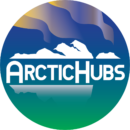Geospatial and scenario expertise to create participatory answers to land use and livelihoods challenges in the Arctic
The Natural Resources Institute Finland (Luke), as the lead of the ArcticHubs project, is leveraging its expertise in geospatial analysis and scenario planning to create participatory tools that enable informed decision-making for various stakeholders in the European Arctic. These tools are co-designed during the project activities with partners and stakeholders to support decision-makers, local communities, industries, and other interested parties in understanding and planning for the region’s future. ArcticHubs’s participatory …
